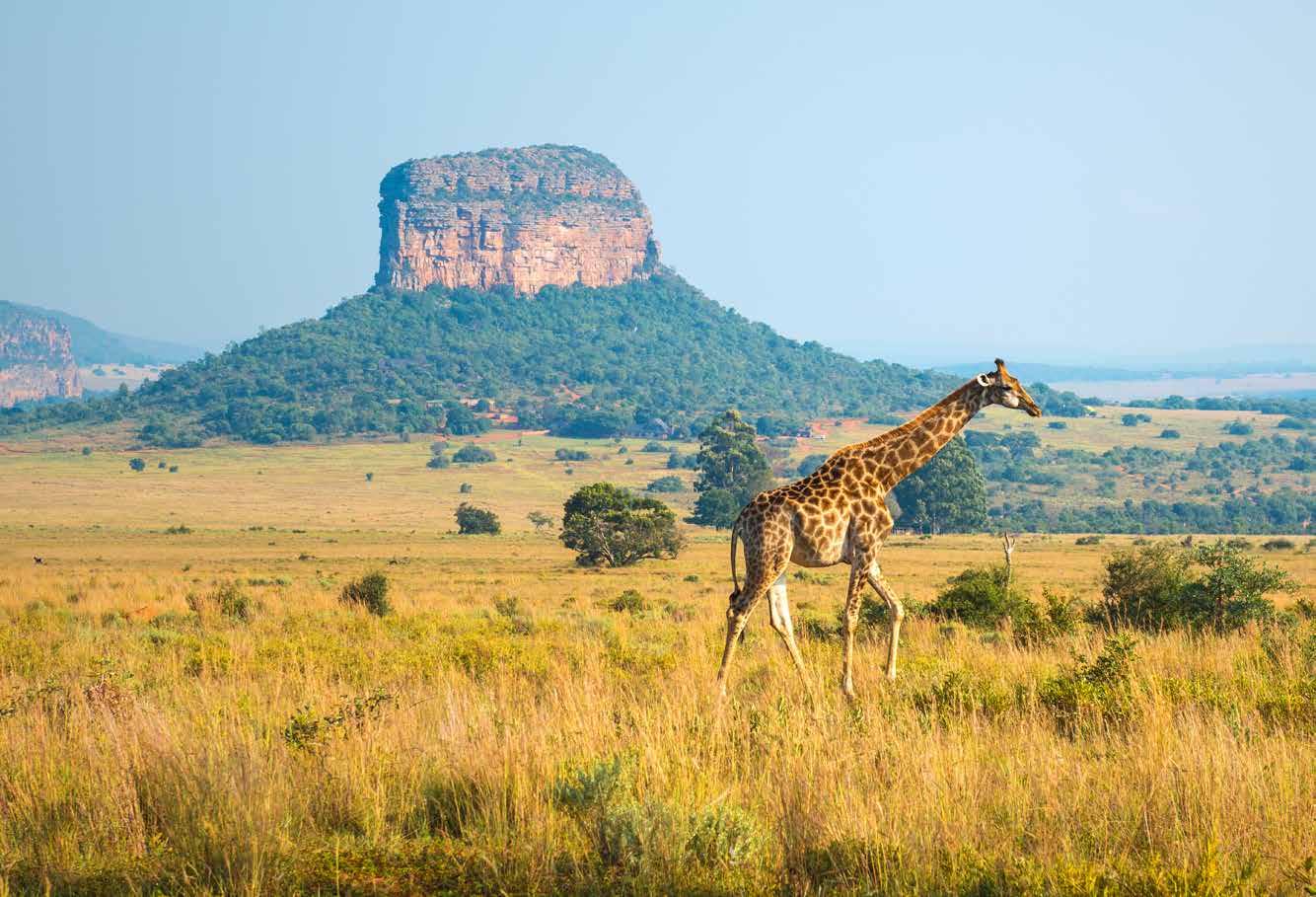
TO VISIT BEFORE YOU DIE BECAUSE
This park and biosphere reserve boasts nice beaches, walking trails, and a wide array of animals – all off the beaten track.


TO VISIT BEFORE YOU DIE BECAUSE
This park and biosphere reserve boasts nice beaches, walking trails, and a wide array of animals – all off the beaten track.
Named for the nearby Gouraya Mountain, which stands more than 2,100 feet tall, Gouraya National Park is located where the cliffs and the coast meet in Algeria’s Bejaia Province. Among the park’s most notable inland inhabitants are the Barbary macaque, a species of monkey endemic to North Africa, and the endangered Algerian hedgehogs, wild cats, and jackals. On the coast, marine mammal sightings could include sperm whales, shortbeaked common dolphins, bottlenose dolphins, harbor porpoises, and the endangered Mediterranean monk seal, which can occasionally be spotted along the rocky shores. Birdwatchers also have the opportunity to observe a plethora of avian species, including eagles, falcons, and migratory birds that pass through the area throughout the year. There are also 13 villages within the reserve, the population of which is primarily of Berber origin.

TO VISIT BEFORE YOU DIE BECAUSE
Botswana’s first national park, this is one of the most biologically diverse conservation areas in Africa.
There are more elephants in Botswana’s Chobe National Park than anywhere else on the planet – the park, known as “The Land of The Giants”, was specifically formed for their protection. Today there are more than 120,000 Kalahari elephants in this preserve, with some herds numbering in the hundreds. But they’re not the only animals in the conservation area: there are also large numbers of buffalos, wild dogs, cheetahs, lions, giraffes, zebras, wildebeest, hippos, hyenas, and more. Part of the reason there’s such a high concentration of wildlife is the Chobe River, an important water source, particularly in the dry season. That vital waterway is one of the best ways for humans to witness this animal kingdom – various companies offer boat safaris, which offer a unique vantage for wildlife watching. In addition to river safaris, Chobe offers classic land-based game drives, allowing visitors to explore more of the park's diverse ecosystems, including floodplains, grasslands, and woodlands.



TO VISIT BEFORE YOU DIE BECAUSE
Every winter, this park becomes a vitally important stopover and breeding ground for thousands of migratory birds from Europe.
Langue de Barbarie National Park, which translates to “Tongue of the Barbarian,” gets its name due to its location, an elongated sandy peninsula which juts out into the Atlantic Ocean. However, its shape is not what this Unesco Biosphere Reserve is best known for. In reality, the park’s most prominent feature is its vital role as a sanctuary for a wide array of avian species, particularly from November to April, making it a paradise for birdwatchers and ornithologists. It serves as an essential stopover and breeding ground for numerous migratory birds from Europe, including pelicans, flamingos, terns, spoonbills, herons, and beyond. More than 160 species birds can be found throughout the park, meaning it plays a crucial role in conservation efforts and in protecting vulnerable ecosystems. The site also hosts numerous reptile species, crabs, monkeys, and five species of threatened marine turtles. If you choose to come to the park independently, know that hiring a guide from the park office is mandatory.

TO VISIT BEFORE YOU DIE BECAUSE
It’s the largest national park in Africa and the oldest in South Africa, and a testament to conservation and biodiversity.
One of Africa’s premier wildlife reserves, Kruger National Park boasts an incredibly diverse ecosystem comprising savannahs, woodlands, and forests, which provide a habitat for an astounding array of wildlife. Here, you can encounter Africa's iconic “Big Five” – lions, elephants, buffalos, leopards, and rhinoceroses – along with a plethora of other species, including giraffes, zebras, cheetahs, hyenas, and countless bird species. Visitors to Kruger National Park are treated to unforgettable safari experiences, whether on guided game drives, walking safaris, or self-drive adventures along well-maintained roads. The park’s numerous rest camps, lodges, and private reserves offer accommodation options ranging from luxurious to rustic, ensuring there’s something for every type of traveler. It’s also worth noting that the park is an exciting destination for archeological enthusiasts – there is evidence that prehistoric men lived in the area over half a million years ago.



TO VISIT BEFORE YOU DIE BECAUSE
The world’s largest gypsum sand dunes are found here, a glistening vision rising from the heart of the Tularosa Basin.
Spread across nearly 275 square miles of the Chihuahuan Desert, this park is renowned for its vast expanse of dazzling sand dunes. The sand is incredibly fine and pure, and because it’s composed of gypsum crystals (a type of calcium sulfate), it has a brilliant white hue that sparkles under the sun. One of the park’s most popular activities is the scenic eight-mile Dunes Drive, followed by sledding down the soft slopes of the dunes in plastic saucers and hiking along the handful of short trails, including the one-mile Dune Life Nature Trail and the 0.4-mile Interdune Boardwalk. In addition to its natural beauty, White Sands National Park is also rich in history and biodiversity. Ancient fossilized tracks reveal the presence of creatures that once roamed this land, while resilient desert flora, like kingcup cactus and rubber rabbitbrush, and fauna, such as roadrunners and coyotes, thrive in this seemingly harsh environment.

TO VISIT BEFORE YOU DIE BECAUSE
This little-visited national park in south central Alaska is the largest in the United States and offers plenty of opportunities for adventure.
It’s hard to talk about Wrangell-St. Elias National Park without using superlatives. Covering over 13 million acres, it’s the largest national park in the United States, and in that vast area are four major mountain ranges, the second and third-highest peaks in North America, and the nation’s largest glacial system. That’s all to say: this is a park with unparalleled opportunities for exploration for hardy adventurers. The most accessible activity? Visiting the Kennecott Mines. From 1911 to 1938, this mining camp pumped out copper around the clock. But when the volume of the high-grade ore diminished, Kennecott became a ghost town. For 60 years, the mill sat abandoned until 1998, when it was purchased by the National Park Service. Now, visitors can tour the 14-story mill, which is still full of machinery, most of which is more than 100 years old. Another good activity? Hiking to Root Glacier. It’s an easy four-mile round-trip trek from Kennecott to the face of the 5,000-square-mile ice flow, which is dappled with otherworldly blue pools and streams.



TO VISIT BEFORE YOU DIE BECAUSE
The famous Great Wall of China runs through this park.
Just northwest of Beijing, Badaling National Park boasts natural beauty, historical significance, and cultural richness. At the heart of Badaling National Park stands the Great Wall of China, a testament to human ingenuity and perseverance. Stretching across rugged mountain terrain, the Great Wall snakes its way through the landscape, offering panoramic vistas of rolling hills and verdant valleys. Constructed initially over two millennia ago, the Great Wall long served as a formidable defensive fortification and a symbol of China’s enduring resilience against external threats. Travelers can hike on or along the wall, explore ancient watchtowers, visit museums showcasing archaeological artifacts, or attend one of the demonstrations and performances to get a better idea of how the Great Wall has influenced (and continues to influence) the culture of China.

TO VISIT BEFORE YOU DIE BECAUSE
A fairytale landscape of sugarloaf mountains, meandering rivers and rice terraces, it’s arguably one of the most famous sights in all of China.
Chances are, if you tell someone in China that you’re going to Guilin, they will let you know it’s the most beautiful place in the country, even if they have never been. They know because it’s the landscape depicted on the back of the 20 yuan bill. Located in the Guangxi Zhuang Autonomous Region of southern China, Guilin is a city that boasts a breathtaking karst topography. Its tall, thin limestone peaks jut dramatically out of the earth, creating a picturesque setting that has long inspired poets and artists. The Li River is the city’s lifeblood, and one of the most popular ways to experience Guilin and the surrounding countryside is by going on a day cruise. Along the way, you’ll likely see fishermen on traditional rafts and modern boats. You’ll also pass the many ancient towns and villages dot the riverbanks, offering a glimpse into traditional Chinese life.



TO VISIT BEFORE YOU DIE BECAUSE
With herds of ibex clambering on its slopes, and pretty mountain villages, this Alpine park boasts great trekking and crosscountry skiing.
Once the hunting grounds for the Savoys, the ruling house of Italy from 1861 to 1946, Gran Paradiso became the country’s first national park in 1922 in an effort to protect the remaining ibex population, whose numbers had reached dangerously low levels (and have since rebounded). It is located between the Aosta Valley and Piedmont regions, and at its heart lies the towering Gran Paradiso massif, after which the park is named, reaching a staggering height of 13,323 feet above sea level. It, and other peaks such as Becca di Monciair and Ciarforon, offer technical challenges for those seeking adrenaline-fueled adventures. There are also more than 300 miles of trails at lower levels, including Giroparco Gran Paradiso and Alta Via Canavesana, which are more suitable to casual trekkers, bikers, or in the winter, cross-country skiers and snowshoers. The park also preserves a handful of villages with high mountain houses, Roman era bridges, churches, and medieval castles, like Malgrà in Rivarolo Canavese.

TO VISIT BEFORE YOU DIE BECAUSE
Postcard-perfect villages, hikes through lemon groves, and swims in the sea – this crowd-pleasing coastal destination has it all.
Overlooking the azure waters of the Ligurian Sea, each of the five pastel-colored fishing villages of Cinque Terre (Corniglia, Manarola, Monterosso, Riomaggiore, and Vernazza) exude its own distinct character and charm. It’s possible to take the train between them, though there’s also a network of scenic trails that connect them, meandering through terraced vineyards and fragrant citrus groves and offering breathtaking views of the coastline along the way. The famous Sentiero Azzurro, or Blue Trail, connects the five villages and provides an exhilarating trekking experience. For something more leisurely, visitors can also relax on sun-drenched beaches and take a dip in the crystal-clear waters or wander through the narrow cobblestone streets in search of artisan shops and trattorias. Cinque Terre is a paradise for food and wine enthusiasts, with its rich culinary tradition rooted in the freshest local ingredients. Sample the region’s famous pesto, made from basil grown in the terraced gardens, savor freshly caught seafood, and indulge in the renowned Sciacchetrà, a sweet wine produced from grapes cultivated on the steep hillsides.


